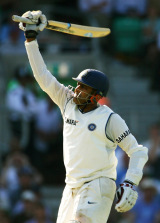The regular Monday column in which Steven Lynch answers your questions about (almost) any aspect of cricket:
Who was the oldest player to score his first Test century? Was it Anil Kumble? asked Brad Cater from Australia
Anil Kumble, a youthful 36, comes in rather surprisingly low on
this particular list, at 14th. The oldest man to score his first Test century was South Africa's
Dave Nourse, who was 42 years and 291 days old when he made 111 for South Africa against Australia at Johannesburg in 1921-22, more than 19 years after his Test debut. Not for nothing was he known as "Old Dave". Every single Indian batsman hit a boundary in the first innings at The Oval. Has this happened before? And there were seven scores of 50 or more. Is that a record too? asked Sriram Sridharan from the United States
We don't have full details from many early Tests, so I can't give a precise answer to the first part of your question - but India's innings
at The Oval was at least the 21st time that all 11 batsman in an innings had hit at least one boundary, the most recent other instance being by Pakistan against South Africa
at Centurion earlier this year. Excluding Mr Extras (who made 54), there were only six scores of 50 or more in India's innings at The Oval, one behind the Test record of seven, which has happened three times, twice very recently: by England against Australia
at Old Trafford in 1934, by Pakistan v India
at Karachi in 2005-06 (uniquely, the top seven in the batting order), and by Sri Lanka v England
at Lord's in 2006.
There were eight fifty partnerships in India's innings at The Oval. Is this a record? asked Irfan Bashir from Hyderabad
India's first innings of 664
at The Oval did indeed contain eight partnerships of 50 or more, which is a new Test record - the previous best was six, which has happened no fewer than 25 times. There were also 17 partnerships of 50 or more during the whole match, equalling the Test record set by Australia and West Indies
at Adelaide in 1968-69. That Adelaide match also included 17 individual scores of 50 or more, which is still the Test record. And by the way, to answer a question posed by several others, India at The Oval (rather neatly) provided the 11th instance of all 11 batsmen reaching double figures in a Test innings.
After the recent centuries by Chaminda Vaas and Anil Kumble, who is the leading scorer among current players in Test cricket without a century to his name? asked Badar Siddiqi from Pakistan
The overall leader here is
Shane Warne, who made 3154 runs in Tests with a highest score of 99, but if you don't count him as a current player then the leader is Muttiah Muralitharan, who currently has 1117 runs and a highest score of 67. The recent centuries by Vaas and Kumble (who made his in his 118th Test, breaking Vaas's previous record of 97 Tests) mean that the only man apart from Warne to have scored more than 2000 runs in Tests without a century is the former India opener Chetan Chauhan, with 2084 (highest score 97).One of my friends told me that Glenn McGrath has scored the most runs as a No. 11 in Tests. But I thought Murali had done this? And who has the highest average from No. 11? asked Uwaisul Karnain from Sri Lanka
Your friend is right ... for now.
Glenn McGrath scored 603 runs from No. 11 in Tests, but
Muttiah Muralitharan is right behind him now with 596. In third place is
Courtney Walsh of West Indies, with 553. The highest average from No. 11, given a qualification of at least ten innings, is 31.66, by England's
John Snow, with 95 runs from ten innings, seven of them not out. The highest average for anyone with at least ten
completed innings at No. 11 is 18.20, by another Englishman, Snow's longtime team-mate
Derek Underwood, who made 182 runs in 27 innings as last man in, 17 of them not outs.
I noticed that Jimmy Anderson, a genuine tailender, has now had 28 Test innings without getting a duck. Is this some kind of record? asked Justin from the UK
England's
Jimmy Anderson has had 28 Test innings now without getting out for 0, and there are only three batsmen in Test history who averaged less than Anderson's 11.18 without ever getting out for 0 -
Peter Philpott of Australia (10 innings, average 10.33), South Africa's
Joe Partridge (12 innings, 10.42) and
Arthur Fielder of England (12 innings, 11.14). No-one else who has had ten or more innings has averaged under 20 without a duck, although Sri Lanka's
Farveez Maharoof currently averages 20.69 from 27 duckless innings."It's perhaps worth adding that in the 19th century at least (not sure when the rule changed), players were allowed a certain number of instances of bowling two overs in a row in order that they could change ends. One of the best examples occurred in this match
at Sydney in 1882-83, when Fred Spofforth of Australia bowled more than 41 overs and his team-mates only managed 39."
